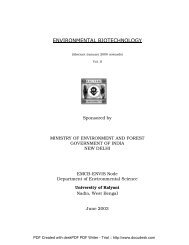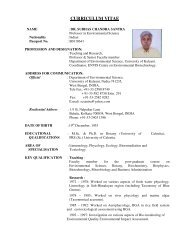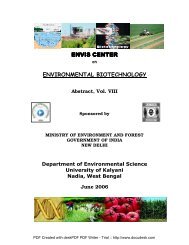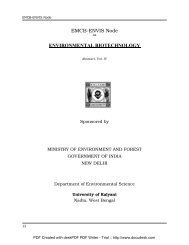EMCB-ENVIS Node ENVIRONMENTAL BIOTECHNOLOGY
EMCB-ENVIS Node ENVIRONMENTAL BIOTECHNOLOGY
EMCB-ENVIS Node ENVIRONMENTAL BIOTECHNOLOGY
Create successful ePaper yourself
Turn your PDF publications into a flip-book with our unique Google optimized e-Paper software.
<strong>EMCB</strong>-<strong>ENVIS</strong> Centre<br />
Thomas A. Davis, Bohumil Volesky, Alfonso Mucci. (Department of Chemical Engineering,<br />
McGill University, 3610 University Street, Montreal, Que., Canada H3A 2B2. Department of<br />
Earth and Planetary Sciences, McGill University, 3450 University Street, Montreal, Que.,<br />
Canada H3A 2A7). Bioaccumulation. Water Research, 37(20) (2003), 4843-4854.<br />
The passive removal of toxic heavy metals such as Cd2+, Cu2+, Zn2+, Pb2+, Cr3+, and Hg2+<br />
by inexpensive biomaterials, termed biosorption, requires that the substrate displays high metal<br />
uptake and selectivity, as well as suitable mechanical properties for applied remediation<br />
scenarios. In recent years, many low-cost sorbents have been investigated, but the brown algae<br />
have since proven to be the most effective and promising substrates. It is their basic biochemical<br />
constitution that is responsible for this enhanced performance among biomaterials. More<br />
specifically, it is the properties of cell wall constituents, such as alginate and fucoidan, which are<br />
chiefly responsible for heavy metal chelation. In this comprehensive review, the emphasis is on<br />
outlining the biochemical properties of the brown algae that set them apart from other algal<br />
biosorbents. A detailed description of the macromolecular conformation of the alginate<br />
biopolymer is offered in order to explain the heavy metal selectivity displayed by the brown<br />
algae. The role of cellular structure, storage polysaccharides, cell wall and extracellular<br />
polysaccharides is evaluated in terms of their potential for metal sequestration. Binding<br />
mechanisms are discussed, including the key functional groups involved and the ion-exchange<br />
process. Quantification of metal–biomass interactions is fundamental to the evaluation of<br />
potential implementation strategies, hence sorption isotherms, ion-exchange constants, as well as<br />
models used to characterize algal biosorption are reviewed. The sorption behavior (i.e., capacity,<br />
affinity) of brown algae with various heavy metals is summarized and their relative performance<br />
is evaluated.<br />
Uguz, Mesude Iscan, Ayse Ergüven, Belgin Isgor, Inci Togan. (Afyon Kocatepe Universitesi,<br />
Veteriner Fakultesi, A.N. Sezer Kampusu, 03100, Afyon, Turkey. Department of Biological<br />
Sciences, Middle East Technical University, 06531, Ankara, Turkey). The<br />
bioaccumulation of nonyphenol and its adverse effect on the liver of rainbow trout<br />
(Onchorynchus mykiss). Environmental Research, 92(3) (2003), 262-270.<br />
Alkylphenol polyethoxylates (APEs) are widely used as nonionic surfactants. Nonylphenol (NP),<br />
one of the derivatives of APEs, has been found in the aquatic environment in ranges from<br />
nanograms per liter to milligrams per liter. In this study, juvenile rainbow trout were exposed to<br />
0 (control), 66, 220, or 660 μg NP/L for up to 28 days. Fish remained healthy under NP<br />
exposures of 0, 66, and 220 μg/L for the length of the experiment. All fish died after 4 days of<br />
exposure to 660 μg NP/L. Time-dependent NP bioaccumulation was detected in the tissues of<br />
fish exposed to 220 μg NP/L (P







